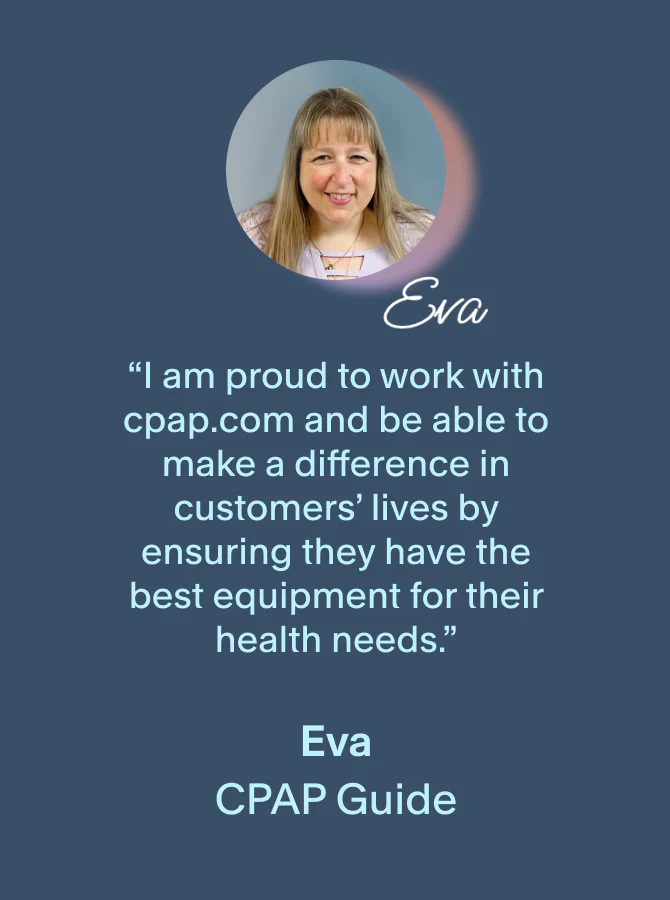Our content undergoes rigorous expert review, evidence-based research, and regular updates for accuracy.
Latest Philips DreamStation News:
12/4/2023
The FDA has recently released a safety communication (NOT a recall) for the DreamStation 2 CPAP machine.
To be clear, this safety notice is not related to the 2021 Philips Respironics Recall that included the original DreamStation. The DreamStation 2 was not part of that previous recall and has not been recalled since.
Original Recall Update (not related to DreamStation 2):
In June of 2021, CPAP.com was notified by Philips Respironics of a recall for certain CPAP, APAP, and BiPAP devices, including the very popular DreamStation. We have kept our customers updated on the situation since those early days.
Since the news broke, customers have let us know they are frustrated and concerned. We agree. All of the relationships we hold dear, our family, friends, coworkers, and customers are affected. We learned of this recall at the same time as our customers and have been in daily communication with Philips Respironics since that time.
Despite sincere and full efforts by members of the Philips Respironics team we’ve been in contact with, details and actions we can take immediately to have a positive impact on the health of our customers have been in short supply.
We have completed all requests by Philips Respironics and we eagerly await a plan that will allow us to provide actionable solutions to customers. We will continue to take any actions Philips Respironics or the organizations governing them approve relating to this recall as quickly as we are able to execute them.
Below is the information you need to know on this recall, how you might be impacted, what next steps should be taken, and what you should expect. Not all details of this recall are known at this time. As information becomes available, we will update our customers via email and the CPAP community at large using this blog.
What Happened?

On Monday, June 14th, Philips Respironics issued a voluntary recall on nearly all of their CPAP, APAP, and BiPAP machines sold from 2009 until today, with some exceptions.
Per Philips Respironics CEO Frans van Houten “We deeply regret any concern and inconvenience that patients using the affected devices will experience because of the proactive measures we are announcing today to ensure patient safety.”
Per the Philips Respironics recall notice:
“We cannot stress enough that Philips is treating this matter with the highest possible seriousness, and are dedicating significant time and resources to address this issue. Our intention is to give affected patients and customers the service they expect and deserve as we resolve this matter as our top priority. This effort includes wide-scale, global ramping up of manufacturing, repair, services, supply chain and other functions to support the correction. We are absolutely committed to supporting the worldwide community of patients who rely on our Sleep & Respiratory Care solutions for their health and quality of life, and the physicians and customers who are dedicated to meeting patient needs.”
Why Did Philips Respironics Issue a Voluntary CPAP Recall?
Philips Respironics identified there is risk the PE-SUR sound abatement foam “may degrade into particles which may enter the device’s air pathway and be ingested or inhaled by the user, and the foam may off-gas certain chemicals. The foam degradation may be exacerbated by use of unapproved cleaning methods, such as ozone, and high heat and high humidity environments may also contribute to foam degradation.”
What Is the Safety Hazard Associated With This Issue?
Per Philips Respironics, possible health risks include exposure to degraded sound abatement foam and exposure to chemical emissions from the foam material. High heat and high humidity environments as well as unapproved cleaning methods such as ozone, may also contribute to foam degradation.
The Philips Respironics FAQs state:
In the event of exposure to degraded foam:
- “The potential risks of degraded foam exposure include: Irritation (skin, eye, and respiratory tract), inflammatory response, headache, asthma, adverse effects to other organs (e.g. kidneys and liver) and toxic carcinogenic affects.”
- “To date, Philips Respironics has received several complaints regarding the presence of black debris/particles within the airpath circuit (extending from the device outlet, humidifier, tubing, and mask). Philips also has received reports of headache, upper airway irritation, cough, chest pressure and sinus infection.”
In the event of exposure to chemical emissions:
- “The potential risks of exposure due to chemical emissions from affected foam include: headache/dizziness, irritation (eyes, nose, respiratory tract, skin), hypersensitivity, nausea/vomiting, toxic and carcinogenic effects.”
- “To date, Philips has not received reports of patient impact or serious harm as a result of this issue.”
Is This an Official Recall?
Yes. Per Philips Respironics, the issuance of the notification is a recall in the U.S., and field safety notice in International Markets, according to regulatory agency criteria.
This recall notification/field safety notice has not yet been classified by regulatory agencies.
As this is an official recall, Philips Respironics must adhere to the regulatory requirements of a recall and specify the steps dealers, such as CPAP.com, must follow to adhere to the recall.
Which Philips Respironics Products Are Impacted?
What CPAP machines are on recall? Many of the Philips Respironics CPAP, APAP, and BiPAP machines sold from 2009 onward except the DreamStation 2 used this type of sound abatement foam and are impacted by this recall.
List of Philips Respironics CPAP Machines Recalled in 2021
Here's a list of Philips CPAP recall model numbers:
| Continuous Ventilator, Minimum Ventilatory Support, Facility Use |
| E30 (Emergency Use Authorization) |
| Continuous Ventilator, Non-life Supporting |
| DreamStation ASV DreamStation ST, AVAPS SystemOne ASV4 C Series ASV, S/T, AVAPS OmniLab Advanced Plus In-Lab Titration Device |
| Non-continuous Ventilator |
| SystemOne (Q Series) DreamStation (CPAP, Auto CPAP, BiPAP) DreamStation Go (CPAP, APAP) Dorma 400, 500 CPAP REMstar SE Auto CPAP |
| Continuous Ventilator |
| Trilogy 100 Ventilator Trilogy 200 Ventilator Garbin Plus, Aeris, LifeVent Ventilator |
| Continuous Ventilator, Minimum Ventilatory Support, Facility Use |
| A-Series BiPAP Hybrid A30 (not marketed in US) A-Series BiPAP V30 Auto Ventilator |
| Continuous Ventilator, Non-life Supporting |
| A-Series BiPAP A40 (not marketed in US) A-Series BiPAP A30 (not marketed in US) |
Skip to: “How do I know if my device was recalled?” section for steps to check your specific machine.
Which Philips Respironics Products Are Not Impacted?
Per Philips Respironics, products that are not affected may have different sound abatement foam materials, as new materials and technologies are available over time. Also, sound abatement foam in unaffected devices may be placed in a different location due to device design.
Products not affected by this recall notification (U.S. only) / field safety notice (International Markets) include:
- DreamStation 2
- M-Series
- Trilogy Evo
- Trilogy Evo OBM
- Trilogy EV300
- Trilogy 202
- BiPAP A40 EFL
- BiPAP A40 Pro
- Omnilab (original based on Harmony 2)
- Dorma 100, Dorma 200, & REMStar SE
- All oxygen concentrators, respiratory drug delivery products, airway clearance products.
How Do I Know if My CPAP Is Recalled?
The best way to know if your device is included in the recall is to register your machine for the recall. During the registration process, Philips Respironics will either let you know your machine is not included in the recall or provide you with a confirmation number.
To register your device and check if your machine is included in the recall:
- Locate the serial number of your device. The label on the bottom of the unit features a series of letters and numbers that follow the SN or S/N on the label. If you need assistance finding your serial number, you can use this handy guide.
- Go to Philips Respironics recall website.
- Complete the registration form. Provide your information such as your name, address, and phone number so Philips Respironics can contact you regarding this recall. Be sure to use your current personal information, regardless of the information you provided at the time of purchase.
- Watch for confirmation. Once you’ve completed your registration, if your machine is not included, you will see a message saying your device is not included in the recall. If your machine was included in the recall, you will receive a registration confirmation number as well as important recall updates from Philips Respironics. Please be sure to save the confirmation number provided for your records. Along with your confirmation number, you will receive information about the next steps in the recall process from Philips Respironics.
How Will Philips Respironics Fix the Issue?
Philips Respironics plans to replace the current sound abatement foam with a new material that is not affected by this issue. This approach needs to go through some regulatory hurdles first. Philips Respironics has provided the relevant regulatory agencies with required information related to the launch and implementation of the projected correction and contracted with a third-party vendor to coordinate the recall effort.
Latest Update Regarding Philips’ Effort To Repair and Replace DreamStation Devices: On September 1, 2021 Philips Respironics issued a statement informing United States-based customers of its new repair and replacement program for first-generation DreamStation devices in relation to the June 14, 2021 recall notification. Philips Respironics received authorization from the U.S. Food and Drug Administration (FDA) to replace the PE-PUR sound abatement foam with a new material, and the company anticipates the rework to begin this month for affected first-generation DreamStation devices in the United States. Philips Respironics is initiating its repair and replacement program in other countries and expects the program to be underway in most markets by the end of September 2021. The company intends to complete its repair and replacement programs within approximately 12 months.
How Long Will It Take for Philips Respironics To Address All Recalled Machines?
Philips Respironics Chief Executive Frans van Houten said, “We’re going to put all our capacity to focus entirely on replacing and repairing these units,” a process he said would likely take a year.
With focusing all capacity on the recall, Houten said that approach “has a consequence that we will not be able to serve new customers, so there’s going to be a shortage in the field.”
We are advocating on your behalf to get quicker updates and more information about the situation as it evolves.
Why Will the Recall Likely Take a Year To Complete?
- The sheer size of the recall. Houten indicated there were between 3 million and 4 million machines targeted in the recall. 80% of the machines treat sleep apnea and around two-thirds of the CPAP machines are in the United States. Using the lower end of the estimate of 3 million, over 52 weeks in a year, that would mean replacing or repairing over 57,000 machines each week.
- Global software chip supply storage. There are software computer chips found in nearly everything - coffee makers, cars, phones, toys, computers, and CPAP machines. There is a global software chip supply due to a variety of reasons including a factory fire, increased demand due to the pandemic, trade wars, and the freeze and blackout in Texas. The shortage is so widespread the US government is forming a task force to address the shortage. A low software chip supply means fewer chips for CPAP machines which means fewer CPAP machines to provide.
- Global cargo backlog. Fueled by the boom in demand for goods, imported cargo shipments to the U.S. are at record levels. U.S. ports have a backlog of ships waiting to be offloaded. Retailers and manufacturers are scrambling to secure placement on cargo ships. Home Depot famously contracted their own container ship to ensure supply. The shortage of spots on ships have led to doubling and more the cost of shipping. Many companies are also moving to the even more expensive air freight option. Once the cargo fits U.S. soil, there is a backlog of trucks available to deliver the orders. Fewer spots on the cargo ship means the already reduced supply of CPAP machines will take longer to get to the U.S.
In summary, the CPAP/APAP/BiPAP machine supply was already tight and shrinking before the recall was announced. With Philips Respironics focusing on the recall, the U.S. CPAP/APAP/BiPAP supply was cut in half overnight. Many dealers expect to run out and go through at least intermittent back order periods for the foreseeable future.
What Is CPAP.com Doing?
Since hearing the news we have been in daily communication with Philips Respironics to understand what aid we can provide our customers.
We have completed all steps with Philips Respironics currently available to help our customers move forward in the process.
We stand by, ready to help Philips Respironics technologically or logistically if needed to quicken getting help to our customers. As new information and options become available to help our customers we will switch our operations accordingly.
We have notified all customers affected by the recall through email and each customer will shortly receive a physical mailed notice.
Each day more information becomes available. We will continue daily checks with the Philips Respironics team to ensure we are executing everything possible to help our customers through this recall.
As we learn more, we will update our customers via email and the CPAP community at large using this blog.
What Is CPAP.com Not Doing?
In compliance with Philips instructions and standard recall practices, CPAP.com is not replacing recalled products with current stock nor issuing refunds for past orders. This is not our choice or our preference.
Should I Keep Using My Recalled Machine?
After you’ve registered your machine with Philips and have scheduled an appointment with your sleep care physician to discuss a new treatment plan, you may be wondering if you should keep using your recalled machine and what options exist if you decide it’s time to purchase a new machine altogether.
Since solutions for the recall are almost as personalized as individual pressure settings themselves, it’s important to have a discussion with your doctor as soon as possible to determine the next steps.
While Philips recommends patients to “discontinue use of your device and work with your physician or Durable Medical Equipment (DME) provider to determine the most appropriate options for continued treatment,” we understand that many are not satisfied with this answer.
We recently spoke with Dr. Daniel Barone, an Attending Neurologist at New York Presbyterian/Weill Cornell Medical Center, to address some of the questions you may have about the recall and the impact it has on your sleep apnea treatment. In the article, Dr. Barone discusses the risks of abruptly ending treatment versus using a recalled device.
For those who cannot currently afford new equipment but who have been encouraged to continue their sleep apnea treatment, we’ve included a few solutions at the end of this article that we hope can be beneficial to you.
Here is the American Association of Sleep Medicine’s guidance to sleep physicians and their guidance to patients regarding the recall.
If you continue using your device, please note that ozone is referenced by Philips Respironics as a potential contributing factor to degraded foam. CPAP.com does not and has never sold ozone-related cleaning products. Last year the FDA issued a safety communication about PAP cleaners. Always follow manufacturer-recommended cleaning instructions.
Additionally, Philips Respironics suggests patients review the age of their devices, as they are typically recommended to be replaced after five years of use.
Alternatives To Replacing Your Recalled Device
After you’ve registered your machine with Philips, you may be asking, “what are my options for continuing therapy while I wait for Philips to send me a replacement machine or repair kit”?
Here are some options to consider:
Purchase a new machine outright
Buying a CPAP machine outright offers several advantages and can be the most cost-effective option. Plus, it usually isn’t as complicated as purchasing a new device through insurance.
Pricing for CPAP, APAP, and BiPAP machines vary; the average cost of a CPAP machine ranges from $300 to $850, though those with advanced technology features can cost more.
Since CPAP.com does not bill insurance or accept Medicare, we are able to offer you the lowest priced machines. You can still file a claim for reimbursement, but keep in mind that reimbursement is fully dependent on your insurance provider. We also offer frequent discounts on our machines, masks, and other CPAP accessories, which can help you save money on the equipment you need. Not all direct-to-consumer brands offer sales and discounts, though.
If you are considering purchasing a new machine to replace your Philips Respironics device, you must have a current prescription. We are happy to review your prescription if you’re unsure of its status. If your prescription has expired, it’s worth considering a home sleep test—which lets you complete a sleep study from the comfort of your own bed—to renew your prescription.
There are many reasons people choose to purchase a CPAP machine outright, even if you have health insurance. You may have a high deductible or perhaps you have preferences for a specific vendor that isn’t covered under your current policy. Plus, most insurance companies require you to rent your equipment for a certain period of time and many require compliance monitoring to protect their investment.
Still, buying a new CPAP machine through insurance is the best option for some.
Ask Your Insurance or Medicare Provider About Your Options
Under normal circumstances, most private insurance companies replace your CPAP machine if you’ve had it for five or more years. As mentioned, receiving a new device through your insurance plan requires a new prescription from your physician with documentation stating that you are using and benefitting from your sleep apnea treatment. However, this recall is not a normal circumstance and different insurance companies will have varying courses of action for you to follow.
No matter what type of health insurance coverage you have, you should call your health insurance group soon to see which steps you need to take once you’ve registered your device and spoken with your doctor. Your insurance company may:
- Approve a rental device of the same caliber and quality as your original equipment
- Determine that the recall voids the standard replacement requirement and immediately replace the device
- Deny covering the cost of a new machine at this time
There are some insurance companies who require the use of a Philips-brand machine only, so you will need to speak with a representative of your insurance company directly to determine a solution for repairing or replacing your current device.
Those who have Medicare are in a similar case-by-case situation. On June 22nd, the American Academy of Sleep Medicine (AASM) and several medical societies and patient advocacy organizations submitted a letter to durable medical equipment (DME) contractors requesting patient support from the Centers for Medicare and Medicaid Services (CMS) since many individuals will be unable to meet CMS adherence requirements before their device can be fixed or replaced. (This includes a request for temporary suspension of the 90-day adherence rule for continued coverage of a PAP device.)
Additionally, the AASM requests flexibility from CMS in allowing and covering the cost of replacing recalled devices during the “five-year reasonable useful lifetime.” The letter suggests DME suppliers should be allowed to repair or replace the recalled equipment without the need for a new clinical evaluation or sleep test; requests for patient alleviation from potential repair or replacement costs were suggested, as well.
The advocacy demonstrated by the AASM has not been confirmed as a solution from CMS, however, so the best course of action is to call your Medicare or Medicaid provider directly regarding new sleep studies, reimbursement for repair costs, or the issuance of a new device.
Your individual coverage with Medicare or Medicaid will determine how to proceed with your device. If you had a CPAP machine before you got Medicare, you will need to check with Medicare to see if you qualify for certain requirements that will cover the cost of the replacement of your machine.
Keep in mind that the CPAP recall is an ongoing situation, so information from your health insurance provider or Medicare may change.
I Can’t Afford a New CPAP, What Are My Options?
If you can’t afford a new machine outright or are having issues with your insurance provider, rest assured that there are several options that exist to find low-cost or free CPAP equipment, including government assistance or charity donation programs. We created this helpful guide to finding a low-cost CPAP machine if you can’t afford to purchase a new machine. We encourage you to read it if you’re experiencing hardship during this recall.
Final Thoughts
While the CPAP recall is a frustrating experience, it does serve as an opportunity to switch up your CPAP equipment set-up so you can find the device that serves your needs best.
If you’re considering purchasing a machine outright and are a long-time user of the DreamStation, we encourage you to check out this article to see how the ResMed AirSense 10 stacks up against the currently-recalled DreamStation from Philips Respironics.
Whether you choose to buy a machine outright or through your insurance company or pursue options through a government assistance program or donation initiative, CPAP.com is here to help you navigate the CPAP recall.
Philips CPAP Recall FAQs
Below you'll find a list of commonly asked questions about the CPAP recall. The information is being updated on a regular basis and answered based on the latest safety communications from the FDA.







